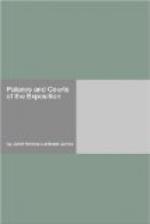All types of men are taking the journey and you are reminded that not alone workmen and adventurers are leading the procession, but ministers, women with their refining influence, children with their school books, and college men with gown and mortar-board, with books under arms — all moving on the long journey westward.
Occupying the same position on the southern side of the arch the companion-piece, by Frank Vincent Du Mond, shows these men from the Atlantic arriving at the shores of the Pacific.
The people of the west with outstretched arms welcome the travelers. The children of the Pacific shores run with flowers and fruits to greet them. You will notice the different types arriving from the Atlantic shore — literary men (with pen and book), architects (with temple in hand), scientists (with book under arm), Franciscan friars (with crucifix and mission bells in hand), etc. These are followed by the Red Coats, indicating those who preserved order. These men are all led by the Spirit of Adventure. She is no longer in the foreground, but is ready to fall behind as soon as she has fulfilled her mission.
The agricultural interests of the western countries are suggested by the wheat and implements of the field. The heavily laden orange trees speak of the fruit industries. Does the tapir stand for South America? Surely, South America is coming into the foreground just now.
The people have now been brought to the shores of the Pacific.
-
The Panama region is the one next to be visited and you rehearse its story, standing under the Tower of Jewels, “The Panama Canal.”
These are the murals of Frank DeLeftwich Dodge:
1. The Panama Isthmus is discovered. 2.
It is purchased by the United States. 3. You
are reminded that the great waters — the Atlantic
and the Pacific
— play with
titanic force on either side of the isthmus.
4. The Panama Canal is completed. 5. Labor
is crowned. 6. The achievements which follow
are shown: (The caduceus, the wand of
Mercury, the symbol
of commerce, is prominent.)
-
Pass thru this Tower of jewels noticing in the eastern and also the western arcades two fine fountains.
On the left is the Fountain of Youth by Mrs. Edith Woodman Burroughs of Flushing, Long Island.
The simple, beautiful, naive figure standing on the pedestal is Youth, the United States, the child that has come from old parents (Europe).
The old father and mother have had many children — many little primroses you will notice — but none more dear than this one. The charming panels will remind you that the old people of today are being rowed by the young. These children row the vessels, bring them to shore and fasten them to their moorings.
Many of the old people are deaf or blind and are straining to follow the young who, with willing hands are guiding them on. A most charming, lovely work is this, and adds a fine touch to the open book that we are reading. Don’t lose the eagle and laurel wreath back of Youth. They are significant.




